The Director-DP relationship is essential because it mixes creative dreams with technical know-how. Think of the director as the captain and the DP as the trusty navigator. When you communicate openly, ideas fly, and visuals come to life, making the story shine. Trust is key too; it helps you tackle challenges together, like when a cloud messes up your perfect lighting! I’ve seen this magic happen on set, where every shared giggle over a camera mishap brings the crew closer. So, if you want to discover how these partnerships transform films into something extraordinary, keep an eye out for more insights!
Key Highlights
- A strong Director-DP partnership ensures alignment of storytelling and visual aesthetics, resulting in cohesive and impactful films.
- Effective communication fosters creativity and prevents misunderstandings, enhancing the overall production quality.
- Trust and rapport between the Director and DP create a safe environment for exploring innovative ideas and solutions.
- Collaborative problem-solving allows both parties to adapt quickly to challenges, such as equipment malfunctions or unexpected changes.
- Respect for each other’s expertise leads to better decision-making and strengthens the overall creative process in filmmaking.
Understanding the Roles

In filmmaking, understanding the distinct yet intertwined roles of the director and the director of photography (DP) is essential for creating a cohesive vision. Think of the director as the captain of the ship, steering the crew toward a specific destination. You’re the one who shapes the story, guiding actors and making decisions about the script. Meanwhile, the DP is your trusted navigator, responsible for the visual journey. They decide how to light each scene, choose camera angles, and create that magical atmosphere you envision. Having the right tools, such as an essential filmmaking equipment like acrylic clapboards, can help streamline communication and enhance the creative process. You might feel like there’s a lot of pressure, and you’re right! I remember my first short film, where I forgot to communicate my vision clearly. The DP went rogue with the lighting, and let’s just say, my characters looked like they were auditioning for a horror movie!
The Importance of Communication
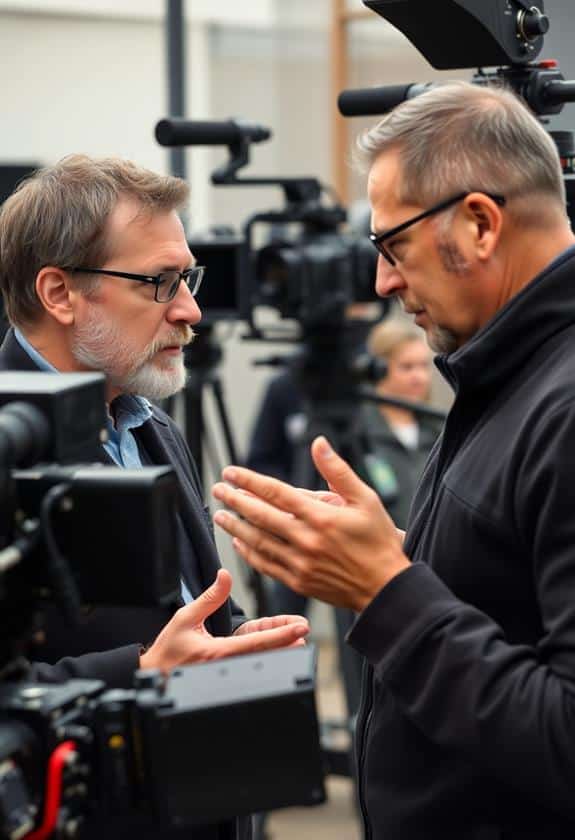
Without effective communication, even the most talented director and DP can struggle to bring their vision to life. Think about it: you’re on set, and the clock’s ticking. If you and your DP aren’t on the same page, it can lead to confusion and mistakes. Trust me, I’ve been there! Once, I was halfway through a scene when my DP had a completely different shot in mind. It turned into a chaotic scramble, and we didn’t get the footage we needed. To guarantee clarity in your audio capture, discussing the importance of audio quality can enhance your overall production value.
To avoid those stressful moments, it’s vital to have open lines of communication. Talk about your ideas, share your thoughts, and even ask for feedback. A simple “What do you think of this angle?” can make all the difference. When you both feel comfortable sharing your opinions, you create a safe space where creativity can flourish.
Shared Creative Vision
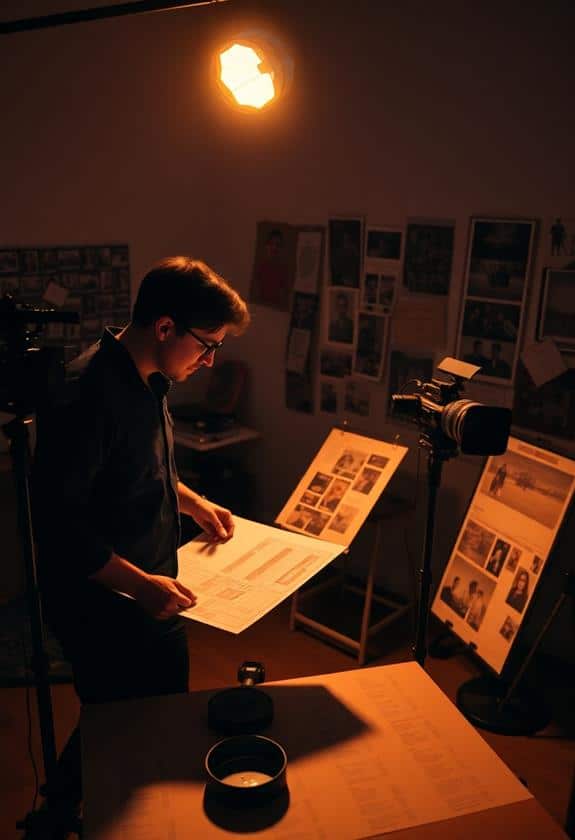
A strong shared creative vision is essential for a successful director-DP collaboration. When you and your DP are on the same page creatively, it creates a safe space for exploring ideas. This connection helps both of you feel secure, knowing that you’re working towards a common goal.
Imagine your film as a beautiful puzzle, where each piece represents a unique idea. Here’s a quick visual to help you picture it:
| Director’s Vision | DP’s Vision |
|---|---|
| Storytelling through emotion | Capturing stunning visuals |
| Unique character arcs | Creative lighting choices |
| Mood set by music | Framing and camera angles |
| Symbolism and themes | Color palettes and textures |
When you align your visions, you create a masterpiece. It’s like being in a dance, each of you moving to the same rhythm. I remember a time when my DP and I brainstormed late into the night, excitedly sketching ideas on napkins. We fueled each other’s creativity, and the result was a film that truly resonated with our audience. So, nurture that shared vision; it’s your best safety net in the unpredictable world of filmmaking!
Technical Collaboration
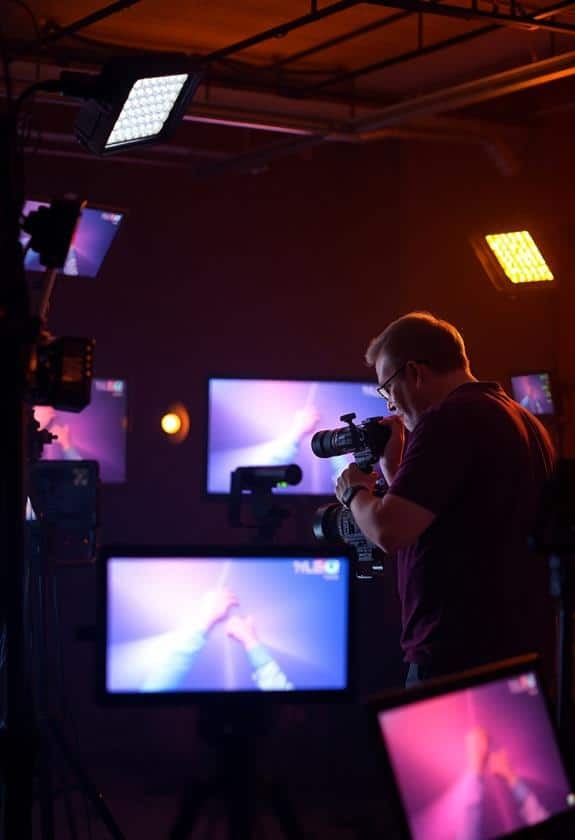
Building on that shared creative vision, technical collaboration between you and your DP becomes the foundation for bringing your ideas to life. You’ll find that discussing camera angles, lighting setups, and lens choices can transform a scene. For instance, when I was working on my first short film, my DP suggested using a wide-angle lens for a more intimate look. It worked wonders! Incorporating effective lighting gear, like the Glide Gear BFS 100 Butterfly Scrim Diffuser, can enhance your scenes by softening harsh light and creating a professional look.
Don’t forget to communicate openly. If you have safety concerns about a particular shot or location, voice them immediately. Your DP wants to create something amazing just as much as you do, and they’ll appreciate your honesty. Remember that lighting can also create mood, so if you want a cozy vibe, try soft lighting.
When things get technical, it can feel overwhelming, but think of it as solving a puzzle together. Each piece—like the camera settings, the shot composition, and the lighting—comes together to tell your story. Plus, a little laughter during stressful moments can lighten the mood, so share a joke or two while you’re working! This collaboration isn’t just about the tech; it’s about building trust and friendship to bring your vision to life safely.
Problem-Solving Dynamics
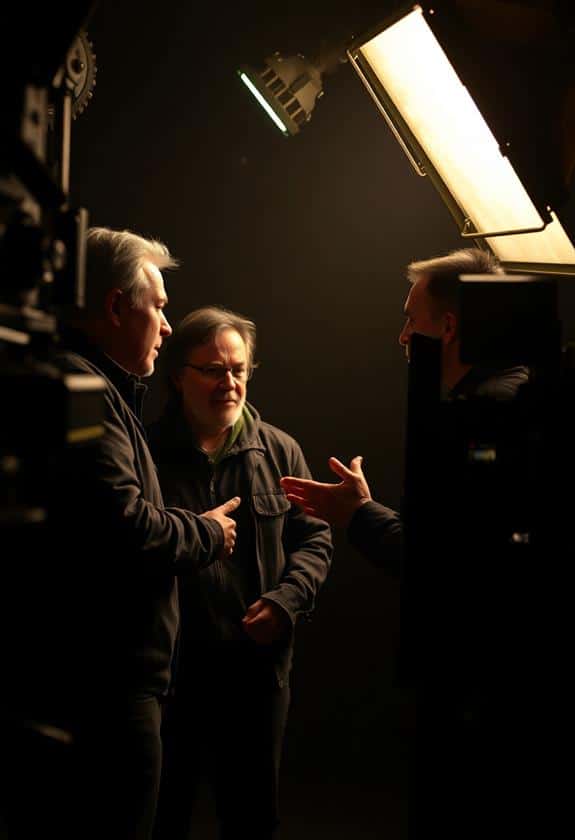
In filmmaking, the director-DP relationship often hinges on how well you tackle problems together. You’ll find that challenges pop up at every corner, but when you and your DP collaborate, you can turn those obstacles into creative opportunities. For example, if you encounter unexpected changes in lighting, having reliable gimbal technology can help you maintain smooth footage even in challenging conditions. Here are three key areas where problem-solving becomes vital:
- Unexpected Changes: Weather forecasting can be tricky. If it rains on your outdoor shoot, you’ll need to quickly brainstorm alternatives.
- Equipment Malfunctions: Imagine a camera suddenly failing during a pivotal scene. It’s your team’s quick thinking that can save the day, whether it’s finding a spare or adjusting the shot to work with what you have.
- Creative Differences: Sometimes, you might not see eye to eye on a shot. Open communication can help you both share your visions and find a middle ground that enhances the film.
Enhancing Storytelling Through Visuals

The way you use visuals can greatly elevate your storytelling. Think about it—when you watch a movie, the images you see often tell as much of the story as the dialogue. As a director, you and your DP work together to create those stunning visuals that capture emotions and set the mood. If you want your audience to feel a character’s joy or sadness, the right lighting and camera angles can make all the difference! Utilizing tools like soft diffusion can enhance the textures and subtleties within your shots, ensuring that every emotion is beautifully captured. For example, remember that time we shot a scene in the rain? The gloomy skies and rain-soaked streets added an extra layer of emotion. It wasn’t just about getting the shot; it was about immersing viewers in the character’s struggle. You can also use color to convey meaning—like how warm hues can create a feeling of comfort, while cooler tones might evoke sadness or unease.
When you think about visuals, don’t forget about composition. Framing your subjects thoughtfully can guide the audience’s focus and enhance the overall story. So, harness the power of visuals, and let your creativity shine! You’ll find that storytelling becomes even more magical when you do.
Building Trust and Rapport

Trust and rapport between a director and their DP are essential for a successful filmmaking experience. When you build a strong connection with your DP, it creates a safe environment where creativity can flourish. Think of it like a dance—you need to know each other’s moves to create something beautiful.
Here are three ways to foster that trust:
- Open Communication: Always share your ideas, concerns, and inspirations with your DP. The more you talk, the better they’ll understand your vision. It’s like sharing your favorite pizza toppings—everyone has preferences, and knowing them helps create a delicious final product!
- Respect Each Other’s Expertise: Remember, your DP has skills and experiences you might not have. Trust their judgment on technical decisions, just as you’d want them to trust your storytelling instincts.
- Collaborate on Creative Choices: Involve your DP in discussions about shots, lighting, and angles. When you collaborate, you both feel valued, and the final product reflects your combined efforts.
Case Studies of Successful Partnerships
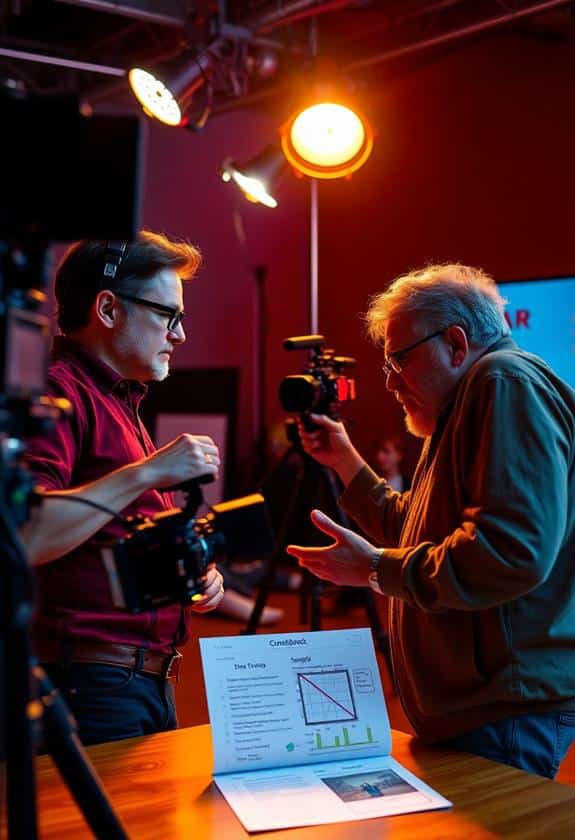
Successful partnerships between directors and DPs often lead to iconic films that resonate with audiences. Think about the dynamic duo of Steven Spielberg and Janusz Kamiński. Their collaboration on films like “Saving Private Ryan” showcases how a strong partnership can create gripping visuals that pull you into the story. You can almost feel the tension of the battlefield, right?
Another fantastic example is Christopher Nolan and Hoyte van Hoytema. In “Dunkirk,” their teamwork captured the urgency and beauty of wartime. You might notice how the camera draws you into the action, making you feel like you’re right there with the characters. This kind of relationship fosters trust, allowing both to push creative boundaries while keeping the production safe and smooth.
When directors and DPs communicate openly, they can explore new ideas without fear. Remember, filmmaking isn’t just about the final product; it’s about the journey, too. So, if you dream of being part of this world, remember that nurturing relationships is key. Who knows? Maybe your partnership will create the next legendary film that touches hearts and inspires minds!
Frequently Asked Questions
How Can a Director Choose the Right DP for Their Project?
Choosing the right DP for your project is like finding the perfect partner for a dance. You’ll want someone who understands your vision and vibe. Start by checking their past work—does their style match what you’re aiming for? Have a chat to see if your ideas mesh well. Trust me, a good connection can make filming smoother and way more fun! Plus, it’s always nice to share a laugh during those long shoots!
What Are Common Challenges Faced in the Director-Dp Relationship?
You’ll find that common challenges in the director-DP relationship often arise from communication gaps and differing visions. For instance, you might want a bright, cheerful scene, but your DP envisions a darker tone. It’s essential to discuss your ideas openly. I remember a shoot where miscommunication led to a totally different look than intended! Trust and collaboration are key, so always keep the conversation flowing and be open to each other’s suggestions.
How Do Cultural Differences Impact Director-Dp Collaborations?
Cultural differences can really shape how you and your director of photography (DP) work together. For instance, if you come from different backgrounds, you might have unique storytelling styles. I remember working with someone from another country, and we had to find common ground in our vision. Embracing those differences can spark creativity! Just keep an open mind, communicate clearly, and don’t be afraid to share your ideas. You’ll create something amazing together!
What Role Does the Director’s Personal Style Play in the Relationship?
You know, a director’s personal style really shapes the whole filmmaking experience. It’s like a painter choosing colors; their vision influences every frame. When you embrace your unique flair, it sparks creativity in the DP. For instance, I once collaborated with a director whose quirkiness made even mundane scenes magical. This connection not only enhances storytelling but also fosters a warm environment where everyone feels valued. So, don’t shy away from letting your style shine!
How Can Emerging Filmmakers Build Strong Director-Dp Partnerships?
To build strong director-DP partnerships, start by communicating openly. Share your vision and listen to their ideas, too. Try collaborating on smaller projects first; it’s a great way to understand each other’s styles. Don’t forget to have fun—filmmaking’s all about creativity! I once struggled with a shot, but my DP’s playful suggestion turned it into a masterpiece. Remember, trust and respect are key; they’ll help you tackle challenges together!
Conclusion
In the end, the director-DP relationship really is the backbone of filmmaking. When you two work together, it’s like a well-oiled machine, blending creativity and technical skill. You’ve got to communicate openly, share your vision, and build trust along the way. Sometimes, things might not go as planned, but that’s just part of the journey. Remember, when you find that groove, the magic happens, and you create stories that resonate with everyone. You’re in this together!




